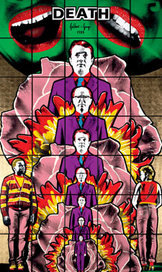Gilbert & George
dal 14/2/2007 al 6/5/2007
Segnalato da
14/2/2007
Gilbert & George
Tate Modern, London
Major Exhibition. The show begins with a documentation of the legendary Living Sculptures together with the idyllic Nature Pieces which include the rarely seen Charcoal on Paper Sculptures. This is followed by pictures of increasingly powerful social engagement including the Drinking Pieces and Human Bondage and culminating in the infamous, black white and red Dirty Words Pictures of 1977. The 1980s and 1990s saw an explosion of colour in their art through which Gilbert & George continued to confront fundamental human issues.

Major Exhibition
This long-awaited exhibition is the largest ever to explore the remarkable art of Gilbert & George. Gilbert & George have created art together since meeting at St Martin's School of Art in 1967. Their impact on the international art world was immediate, radical and subversive with the declaration that sculpture need not be confined to the production of three-dimensional objects and that their own lives could be classed as ‘living sculptures’. Since then, their joint existence has been one long art journey which has led to major exhibitions in five continents, including pioneering shows in Russia and China.
The exhibition begins with a documentation of the legendary Living Sculptures together with the idyllic Nature Pieces which include the rarely seen Charcoal on Paper Sculptures. This is followed by pictures of increasingly powerful social engagement including the Drinking Pieces and Human Bondage and culminating in the infamous, black white and red Dirty Words Pictures of 1977.
The 1980s and 1990s saw an explosion of colour in their art through which Gilbert & George continued to confront fundamental human issues. Among the comprehensive selection of works from this compelling period are the Tate's own vast quadripartite Death Hope Life Fear, the phantasmagorical Life Without End, the scandalous Naked Shit Pictures and the instinctive Fundamental and New Testamental Pictures featuring the artists' own blood, tears, spunk, piss, shit and sweat.The final section of the exhibition explores Gilbert & George's visionary twenty-first-century art. Beginning with the promiscuous New Horny Pictures and mesmerising lice-infested East One Pictures, followed by the Gingko Pictures of Venice Biennale fame, these works continue to ask provocative questions about sexuality, identity and religion. The show ends with the controversial Sonofagod Pictures including the epic Was Jesus Heterosexual? which led to accusations of blasphemy. Gilbert & George have also created completely new pictures for this exhibition.
Gilbert & George have created an important new group of six pictures for their major forthcoming retrospective at Tate Modern. The Six Bomb Pictures, the only pictures created by the artists in 2006, comprise a 14 metre triptych entitled Bomb and five other pictures: Bombs; Bomber; Bombers; Bombing; and Terror. The artists have described this group of pictures as their most chilling to date.
The main component of the pictures is 136 sandwich board posters, which Gilbert & George have been collecting for over two years, featuring headlines from London’s Evening Standard. Of these, 13 contained the word bomber, 19 the word bombers, 15 the word bombs, 16 the word the word bombing, 14 the word bomb and 29 the word terror.
The artists intend the pictures to be seen as modern townscapes reflecting the daily exposure in urban life to bomb threats and terror alerts. In the wake of the recent bombings in London they are also intended to be viewed as commemorative, each functioning as a memorial with its title written on a tombstone, symbolic of the ultimate sacrifice. In the triptych, Bomb, the London Plane tree can be seen, the city’s tallest living form and nature’s symbol of continuity. The artists have also featured the fruit of the tree in some of these pictures, referring to the millions of seeds contained therein, alluding to regeneration and hope. The artists are also featured in the pictures, shown variously as guards, witnesses and exploding atomised beings standing in ashes.
Since the early 1970s Gilbert & George have created pictures in series or groups of black and white, then coloured, pictures. They began to introduce bold colours in the early 1980s and subsequent groups usually include one or more pictures realised on a monumental scale. Each shares common motifs and conceptual and formal elements. Among the themes that recur are religion, sexuality, race and identity, what it is to live in a metropolis and the tensions and desires that can arise from the proximity of disparate cultural traditions and values.
Opening: 15 february 2005
Tate Modern
Bankside - London
Exhibition Hours: Sunday to Thursday, 10.00–18.00. Friday and Saturday, 10.00–22.00
Admission: 10 pounds



